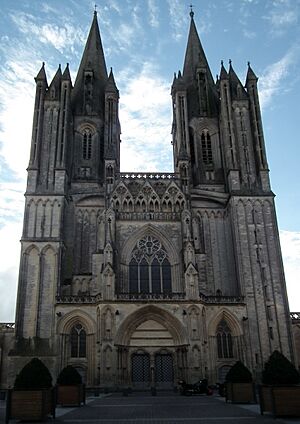Geoffrey de Montbray facts for kids
Geoffrey de Montbray (died 1093) was a powerful Norman nobleman. He was also known as Geoffrey of Coutances. He served as the Bishop of Coutances. Geoffrey was a trusted advisor to William the Conqueror. He was known as a strong leader and administrator. His nephew, Robert de Mowbray, became his heir.

Contents
Early Life and Becoming Bishop
Geoffrey likely came from Montbrai, a place in Normandy, France. In 1049, he became the Bishop of Coutances. His brother, Malger, helped arrange this. Geoffrey was made a bishop in Rouen on March 12, 1049.
Later that year, at a meeting called the Council of Reims, Geoffrey faced a serious accusation. He was accused of buying his bishop position. This was against church rules. Geoffrey defended himself by saying his brother bought it without his knowledge. He promised he was honest and was allowed to keep his position.
Rebuilding His Diocese
When Geoffrey became bishop, his church area was in very bad shape. For almost 100 years, the churches in the Cotentin area had been ruined. This was because of attacks by Northmen. There were few church leaders and almost no books or bibles.
Many bishops before him had lived far away. This meant they did little to fix the church. Geoffrey worked hard to rebuild and restore the churches in his diocese.
A Key Figure in England
Geoffrey was present at the famous Battle of Hastings in 1066. After William the Conqueror won, Geoffrey played an important role. At William's coronation, Geoffrey helped introduce the new king to his French-speaking subjects.
As a reward, William gave Geoffrey large amounts of land. This land was spread across 12 different counties in England. Geoffrey also went with William on a trip to Normandy in 1067.
Stopping Rebellions
When William returned to England, many English people rebelled. Geoffrey took a leading role in stopping these uprisings in 1069. While William marched north, Geoffrey gathered soldiers. He led them to victory against rebels who were attacking Montacute Castle.
In 1075, Geoffrey again helped put down a rebellion. He led a large army with Bishop Odo. They fought against Ralph de Guader, the Earl of Norfolk. They captured his stronghold at Norwich.
Important Legal Work
William the Conqueror also gave Geoffrey important legal jobs. In 1072, Geoffrey oversaw a major court case in Kent. He also handled other important legal disputes. It is believed he helped with the Domesday Book in 1086. This book was a huge survey of land and wealth in England. Around the same time, he was put in charge of Northumberland.
Later Years and Death
Geoffrey attended William the Conqueror's funeral. After William's death, Geoffrey joined a rebellion in 1088. This rebellion was against William's son, William Rufus. Geoffrey used Bristol, where he had built a strong castle, as his base. He attacked Bath and other areas. However, he soon surrendered to the king.
He later went back to Normandy. Geoffrey de Montbray died in Coutances in 1093. He remained loyal to Duke Robert, William the Conqueror's eldest son.
What People Said About Geoffrey
A writer named Orderic Vitalis wrote about Geoffrey de Montbray. He said that Geoffrey was proud of his noble family. He was known more for his skills as a military leader than as a churchman. Orderic Vitalis said Geoffrey knew more about leading soldiers than teaching church songs.
Geoffrey was part of a close group of noblemen. Many of these nobles became bishops during William the Conqueror's rule.

